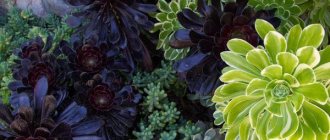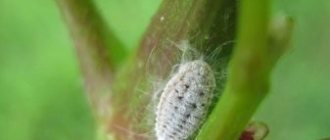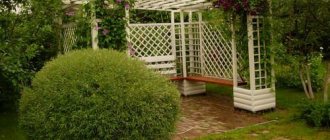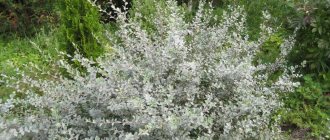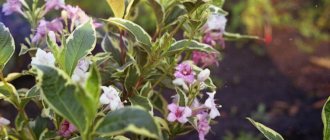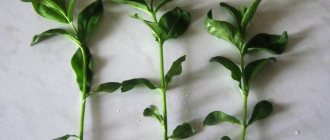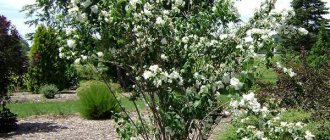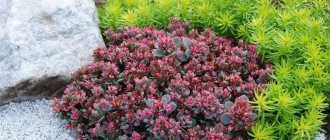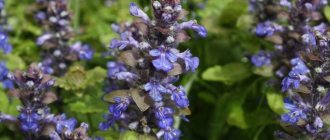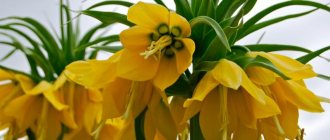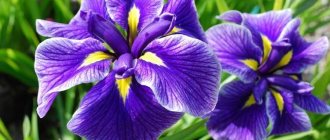Japanese red fan maple. Description and varieties of red maple
Red Japanese maples include: palmate, fan and Japanese maples, and many more varieties that were bred by breeders based on the above.
From the name of the tree you can understand that the birthplace of the Japanese maple is the Land of the Rising Sun. They differ from each other by carved leaves, which have purple or bright orange colors and shades, and another difference is the crown.
The size of the trees depends on their type; they are three meters wide and up to eight meters high. Palm maples can be taller, while fan maples are a low-growing species. The flowers of red maple are small, their color is red or yellow-green, the color depends on the variety. After flowering, the flowers turn into lionfish seeds, these seeds are scattered over many kilometers and later new trees grow from them. These trees are very beautiful and will decorate any garden or park.
Types of trees:
- Japanese fan. This tree has several varieties, they are small, have a crown of a very original shape, the leaves are golden or red, they are very similar to a lace fan.
- Palm-shaped, red Japanese variety. This species is the most beautiful among Japanese maples, this is so because its leaves remain purple in summer and autumn. They are also very beautifully shaped, they can be either five-fingered or nine-fingered, the leaves are made up of long lobes. This species grows very slowly, can reach five meters in height, and the crown diameter is approximately three meters. The flowers of this tree are red and bloom begins in June.
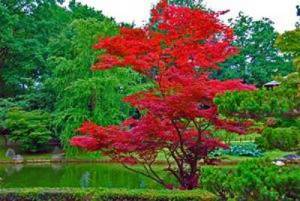
Japanese. This plant has very beautiful and graceful leaves. The leaves change color from spring to autumn, that is, the entire growing season. In spring they are bright green, and in autumn they are yellow, orange, burgundy and cherry. This variety of trees is very afraid of frost, which is why they are often grown in greenhouses and winter gardens.
In addition to the above varieties, there are many hybrid forms that were bred in Japan. Here are some of them:
- The species "Bloodgood" differs from others in its inky black leaves.
- Variety "Beni Kava". This tree has ruby bark and bright scarlet or fiery red leaves.
- The Katsura species has red leaves that turn green in the summer and turn golden in the fall.
- Species "Nicholsonii". Its leaves are green in summer and change into brick-red in autumn.
- Variety "Aconitifolium". This tree is multi-stemmed, has curved branches and dark red leaves.
- The species "Mikawa yatsubusa" is a small tree, approximately one and a half meters in height, it is dense with a squat crown. The leaf blades are thin and needle-shaped, bright green in summer, and orange-scarlet in autumn.
- Species "Shino Buga Oka", this species reaches only one meter in height. The tree is incredibly spreading. It has decorative leaves that are bright green in summer and yellow-orange in autumn.
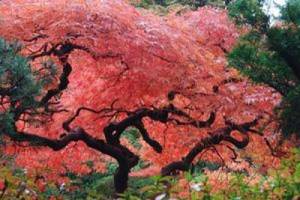
Shirasawa's species - this maple is incredibly small, its height is only one and a half meters. It has wide leaves with a border along the edges, their color is yellow-orange.
How to care for mature trees
When the plant has grown and become strong enough, caring for it does not require much effort. Red maple after planting and up to four years of age requires care in terms of fertilizers. After this, minerals should be added to the soil no more than once every two years. Many ornamental plants are adapted to grow in wild conditions, for example, in the forest, where no one cares for them. And at the same time, trees grow normally for 100-150 years. But an ornamental tree requires care in order for it to remain beautiful and bright.
To do this, cut off some branches, especially dried ones. You also need to cut down all the branches that interfere with growth. Experts recommend not cutting off the shoots; the maple plant should be branched. The tree can be given a beautiful rounded crown. The ideal season for tree pruning is August-December. If you do not comply with these time limits, the plant may begin to “cry”.
Read also: Soviet Merino: characteristics and descriptions of the sheep breed with photos
Japanese maple aconitifolia. Types and varieties
The genus of maples today has more than a hundred species and thousands of varieties. The category of Japanese representatives includes 2 deciduous species:
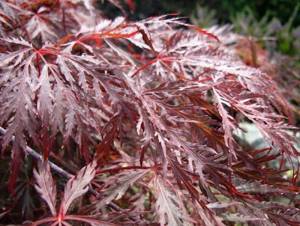
Attention! Japanese maples are found in natural conditions on the territory of the Sakhalin region, and due to their scarcity they are listed in the Red Book.
The most attractive varieties for the garden are:
- A. japonicum aconitifolium (monkshood) is a tree-like shrub that is decorated with large, deeply dissected leaves in fiery orange, burgundy and yellow shades;
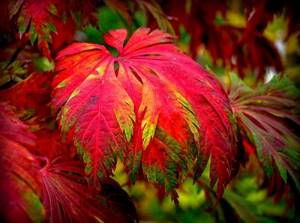
A. japonicum aconitifolium
- A. japonicum vitifolium (grape-leaved) - characterized by slow growth and picturesque rounded fan-shaped foliage, turning bright crimson in autumn;
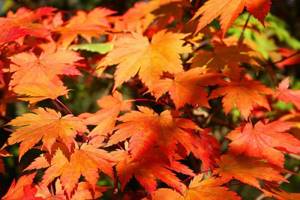
A. japonicum vitifolium
- A. palmatum sangokaku (maple with coral bark) - in addition to decorative deeply cut leaves with a pink border, it surprises with its spectacular coral-red bark;
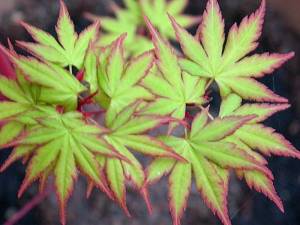
- A. palmatum Garnet is a small graceful tree with lacy leaves and low hanging branches. The thin-lobed leaves vary in hue from deep red to dark purple, transitioning to deep crimson;
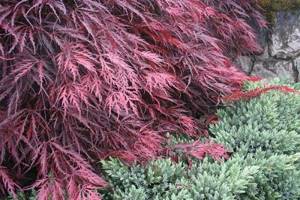
A. palmatum Garnet
- A. palmatum Katsura is a compact variety that produces purple-red flowers in early spring. In spring, the leaves are yellowish with a richer brick edging. At the height of summer, the maple changes color to an unremarkable green, and by autumn it turns orange;
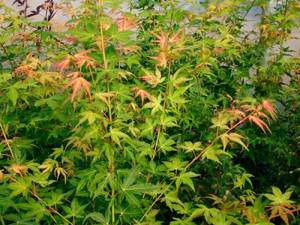
A. palmatum Katsura
- A. palmatum Butterfly - sports 5-lobed silver-green foliage that sometimes curls flirtatiously. In spring you can notice pinkish touches, and in autumn the place of the silvery shade is taken by rich purple.

Features of caring for Japanese maple
Red maples do not require heavy pruning, but it is worth cutting off dead branches and diseased parts. In spring, crop care includes replacing the top layer of soil with a new one, as well as preliminary enrichment of the soil using complex types of fertilizers. The mixture should be prepared from 40 grams of urea, 30 grams of superphosphate, and 25 grams of potassium salt. The tree trunk circle should be covered with a special mulch so that it can maintain the required level of moisture in the plant and also protect it from the appearance of crust. Watering in the summer season should be carried out in conjunction with fertilizing and loosening the soil around.
Red maple can tolerate a small amount of soil moisture well, but it can lose all its graceful qualities and attractiveness.
The regime of watering and fertilizing the crop should be regulated in a certain way, depending on the climatic conditions at the site where the plant is planted and general weather conditions. The winter hardiness indicator will mainly depend on the fruit itself, the variety, and the general age of the crop.
In autumn, the roots of young trees and shrubs in the garden area should be insulated with dry leaves, and the containers should be brought back into the house.
Japanese maple garnet. Description
Katsura maple (Acer palmatum 'Katsura', Acer palmatum var. dissectum 'Katsura'). Maple "Katsura" pleases with very bright yellow foliage. Therefore, this tree will become a real decoration for any garden, but especially for an oriental-style landscape (gravel garden, pond bank, in the middle of a lawn, etc.). It looks particularly impressive against a background of shrubs such as juniper or yew, and is also suitable for composition with azaleas and rhododendrons in the understory. It is loved for the shape of its crown and leaves. Its beauty will not leave you indifferent either! This plant is also called differently: Japanese maple or palm maple. It is a slow-growing shrub or small tree that typically reaches heights of up to 1.5 to 6 m in height. The width of the plant is 1.5-4 m. Its homeland is Japan, Korea and China. IP Kharchenko gives you the opportunity to order Japanese maple seedlings that will give you joy and warmth.
Katsura is a compact, low-growing variety. It is better known for its beautiful spring foliage. Small, palmate, 5-lobed leaves up to 2.5 cm long. They appear in spring yellow-green with orange-tinted edges. In summer they are bright green and their borders turn pink. And finally, in the fall, they take on pastel shades of orange and yellow. The leaf lobes are lanceolate, with thin tips and fine serrated edges. Fan maple flowers are small, reddish in color, collected in panicles. They appear in the spring, from April to May. They are attractive upon closer inspection, but not striking from a distance. The lionfish fruit ripens in September-October. The lionfish are red at first and then turn grey. This variety, as a rule, has a through, umbrella-shaped crown. It grows up to 4m in height during the first 10 years, and gradually the crown becomes more rounded with age. It grows slowly and when it reaches only about 2 m in height, then it begins to spread its branches to the sides. This results in an almost equal size in height and width. The plant does not require pruning, but many gardeners prefer to shape it. The small reddish flowers are somewhat attractive upon closer inspection, but not showy from a distance.
Wintering red maple
Red maple is a winter-hardy ornamental plant. It does not require special shelter for the winter. Only young seedlings can freeze in harsh snowless winters.
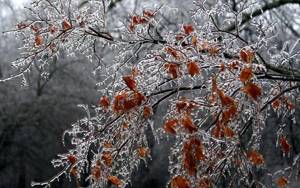
To cover a small tree, a frame is built, which is wrapped around with non-woven covering material. To prevent the roots from freezing, pour a thick layer of mulch into the tree trunk circle.
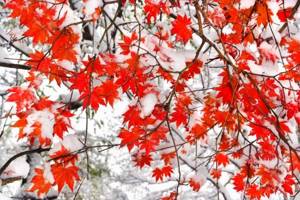
To successfully winter maple trees, stop feeding them with nitrogen-containing fertilizers in mid-summer. To prepare for frost, the tree only needs potassium and phosphorus. In the fall, before the soil freezes, you can carry out moisture-recharging irrigation, which will protect the root system from damage.
Japanese maple palmatum. General information with descriptions of varieties
Japanese maples include palm maple (Acer palmatum), fan maple (Dissectum), and Japanese maple (Acer japonicum), as well as numerous varieties bred on their basis by breeders.
As the name suggests, Japanese maples are native to the Land of the Rising Sun. All of them are distinguished by decorative carved leaves of purple and bright orange colors and shades, and a beautiful crown structure.
The sizes of Japanese maples, depending on the type, range from 2-3 meters to 8 meters in height. Palm maples are taller, while fan maples are shorter. The flowers are not large in size and have a yellow-green or red color, which depends on the variety. The flowers produce lionfish seeds, which are scattered over long distances, growing into new trees. Many Japanese maples are distinguished by their decorative crown and bark. Due to these features, the tree becomes a real decoration of the garden or greenhouse.
In addition to the basic varieties, there are many hybrid forms bred in Japan. Each of these forms has a name that conveys the peculiarity of the variety; the main thing is to understand them correctly.
- Shirasawa maple (Acer shirasawanum) is one of the smallest, about 1.5 meters high. Its leaves are wide, with a border along the edges, and yellow-orange in color.
- The variety "Bloodgood" has a unique inky black leaf color.
- The Beni Kava variety has bright scarlet, light leaves and a fiery red, ruby hue of bark.
- The Katsura variety has red young leaves that turn green in summer and golden in autumn.
- The 'Nicholsonii' variety has green leaves in summer and brick red leaves in autumn.
- The variety "Aconitifolium" is multi-stemmed, with arching branches and dark red foliage.
- The variety "Mikawa yatsubusa" is distinguished by its small size - up to 1.5 meters, dense, squat crown. Its leaves consist of thin, needle-shaped lobes, bright green in summer and orange-scarlet in autumn.
- The variety "Shino Buga Oka" is short in height, from 1 meter to 1.2-1.3 meters in height. The plant is very spreading, with decorative leaves, bright green in summer and yellow-orange in autumn.
How to plant a plant
Plants should be planted in mountain gardens, where they can look beautiful with perennial coniferous crops. At the foot of a tall crop, which can reach four to five meters in height, you should plant perennial flowers that will not require special lighting. An umbrella-type crown can create a cozy shade in the very corner for relaxation; it looks beautiful with plants that are common in the central part of the country.
- Such crops with red leaves look very attractive when planted alone, as well as in limited plantings in groups. When planting, it is worth maintaining a certain distance between seedlings from one and a half to three and a half meters. The pit should be prepared in advance to a depth of fifty to seventy centimeters. If planting takes place in a heavily marshy area, then it is imperative to create a good drainage layer. The hole should be filled with water and a complex of organic fertilizers should be added to it.
- Some varieties of maple with red leaves have been bred by breeders to be grown in special tubs or containers. Such crops do not exceed one and a half meters in height. Maple should be planted in a mixture of equal amounts of compost, peat, and turf soil. The culture that is grown in the pot itself does not like a lot of humidity. Watering red maples, and those trees that grow in tubs, as well as those growing in open ground, must be combined with special fertilizers. The regularity of watering the plant will directly depend on the area of growth, growing conditions and weather outside.
- If the plant lacks moisture, it will not die, but will lose its decorative effect.
When caring for a maple, you should pay more attention to its pruning. It is only enough that you cut down damaged branches and dry branches from time to time. It is worthwhile to promptly seal all damage and deformations on the tree bark structure with a garden varnish in order to protect the plant from infection and various parasites.
But the plant will become especially decorative if it is in the hands of a skilled and professional gardener. After pruning, trees acquire a very beautiful and graceful appearance, and in combination with the beautiful color of the foliage this can produce an attractive result.
Read also: 10 best gasoline lawn mowers - rating 2018
Japanese maple fertilizer. Collecting and planting seeds
Japanese maple reproduces by seeds, which are collected in October. They are stratified in preparation for planting. Then they are laid out in sandy, dry soil and stored in a cool room.
In early spring, planting material is treated with a growth stimulator and sown in special containers. Over the summer, the seedlings grow well, after which they are sorted, leaving tall and strong shoots. Seedlings grown from seeds should remain indoors in their containers for their first winter. Then they are transplanted into pots, each separately. When the plants grow, they are planted in open ground.
Japanese maples are extremely spectacular ornamental trees and shrubs. Even in winter, deciduous Japanese maples captivate the eye with their unusual shape of a bare crown, reminiscent of a mushroom or umbrella, and many thin fan-shaped branches. However, the peak beauty of Japanese maples occurs in autumn, when their leaves turn stunning bright colors: red, orange, gold...
The maple genus (Acer) consists of approximately 110 species of deciduous (rarely evergreen) trees and shrubs that grow naturally in the moist forests of Europe, northern and central America, and Asia. Here we will talk only about a certain category of maples, which are usually called Japanese maples, because they originate from Japan and Korea. The group of Japanese maples includes only two species: the Japanese maple itself (Acer japonicum) and the palmate or mountain maple (Acer palmatum) with its especially decorative variety, the fan maple (Dissectum). Fan maples have dissected, feathery leaves that resemble a lace fan. Japanese maples began their victorious march in European garden culture back in the 1600s, and by 1882, 202 varieties of these trees were already known in Britain. Garden centers now offer several hundred varieties of Japanese maples, which are distinguished primarily by leaf color, which is especially spectacular in the fall when maples dramatically change color to red, gold, or orange.
Red maple: characteristics and biological features
The genus Maple (Acer) includes more than 160 species. It grows without any problems in any soil except swampy ones. This plant is interesting for its shades of red. Like all plants, maples contain chlorophyll, which turns the leaves green in summer. However, in addition to chlorophyll, it contains carotenoids and anthocyanins, which give the leaves different colors: yellow, orange, red, etc.
The crown of the plant has a round or oval shape. Sometimes it looks like a porcini mushroom. The bark has a light silver color, which harmonizes with the red leaves. The leaves of the tree can be three- or five-lobed. This type of tree tolerates our climate well. Red maple has good frost resistance and can withstand down to -20 ºС. The plant does not like constant exposure to direct sunlight and strong moisture.
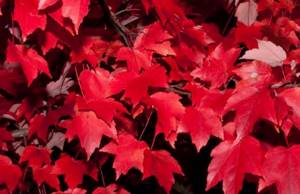
It is recommended to prune and rejuvenate the tree from late August to early December. This cannot be done in the spring, as the tree actively absorbs nutrients from the soil and you can harm it. The vaccination is done in spring or summer using the budding method.
Japanese maple bonsai. Japanese maple bonsai: buy at Fitosystems.ru.
The catalog of our store presents various maple bonsai trees, the price of which is lower than in other stores. If a plant of the height you need or the variety you need is not in stock, you can buy it to order with a short waiting period. We send maple bonsai to different cities, such as: St. Petersburg, Rostov-on-Don, Tver, Vladimir, Nizhny Novgorod, Kostroma, Smolensk, Tula, Sochi, Yekaterinburg, St. Petersburg and many others! You can also buy a plant by mail in our online store. Absolutely all plants are carefully packaged, and if you buy in winter, the plant is packaged with insulation and can easily be transported.
These insects feed on the plant's plant fluids and the plant's plant fluids and thus cause damage to the structure of the plant. Symptoms of the presence of cochineal can be recognized by yellowing of leaves, from Knows about spots from fading of foliage. If Coccinella is present, remove the whitish encrustation from the branches and spray the plant with specific solutions.
Does outdoor bonsai sound strange to you? We are used to growing bonsai in our homes, but few people know that many of these plants can be treated outside, especially during the beautiful season, with excellent results. We discover together what a bonsai is like outside, what their resistance is and what medicines they need.
But dwarf maple varieties for bonsai are unpretentious and seem to help a person with their formation. They do not tend to grow upward, but form a dense crown covered with small foliage that preserves its natural appearance.
How to grow red maple on the plot
Thanks to its extraordinary decorativeness and flexible nature, maple is often used in landscape design in the Moscow region. Planting and caring for maple does not cause any particular difficulties, and the returns from it are very high. The tree is undemanding to soil and tolerates frost. And if the young shoots freeze in winter, in the spring it will grow new ones.
Read also: How to uproot a stump with your own hands without effort video
Landscape design studio STROY-LAWN invites you to create a design project for your site, as well as professionally carry out planting and landscaping work.
Elegant foliage attracts attention throughout the warm season. In spring, inflorescences of small bright yellow fragrant flowers stand out clearly against the background of blossoming burgundy leaves. The grown leaves turn green and take on the shape characteristic of each species and variety: five-fingered, carved, pointed. There are variegated forms of maples with variegated foliage. All summer long, bright red, pinkish, yellowish-green clusters of winged fruits stand out against the background of maple greenery. In September, the ripened seeds lose their brightness, but it is then that the leaves begin to change their color. In different species they are scarlet, yellow, orange, pink, burgundy.
And even the trunks of these trees can be decorative. The Tatarian maple has black bark, while the fan maple has greenish, light brown, beige bark. There are several varieties of snakebark maples. Their trunks are covered with an unusual “snake” pattern: alternating white and green or brown vertical stripes.
Planting and caring for a maple tree does not include trimming. This is one of the few trees that independently forms a beautiful, dense, symmetrical crown. If the plant is not used in a green hedge, it does not need to be pruned annually. The trunk grows straight and slender, and the beneficial shade of the dense crown saves the surrounding area from the heat.
